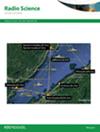利用高采样率蜂群回波(e-POP)测量低纬度原地不规则性和顶层 GPS 信号强度的功率谱特征
IF 1.6
4区 地球科学
Q3 ASTRONOMY & ASTROPHYSICS
引用次数: 0
摘要
低纬度电离层密度结构的大小从数千公里到几米不等。射频(RF)信号,例如来自全球导航卫星系统的信号,在不规则结构中传播时会受到相位和强度快速波动的影响,即所谓的闪烁。在这项研究中,我们利用蜂群回波(CASSIOPE/e-POP)卫星的全球定位系统掩星(GAP-O)接收器在其天线重新定向为垂直指向后进行的高采样率测量,同时利用 e-POP 离子质谱仪的表面电流观测作为等离子体密度的替代指标,获得了全球定位系统信号强度和高度为 350 至 1280 千米的原地不规则现象的频谱特征。我们的研究表明,这两种测量结果的功率谱一般都可以用幂律来描述。就密度不规则而言,出现率最高的频谱指数约为 1.7,这与之前的研究结果一致。此外,本研究中 GPS 信号强度的所有功率谱都显示出接近 2 的单一谱指数。此外,本研究估计的滚降频率在 0.4 至 2.5 赫兹之间,明显高于低纬度地面 GPS 接收器计算的菲涅尔频率(0.2 至 0.45 赫兹)。频率增加的部分原因是 Swarm Echo 在近地点附近的轨道速度为每秒 8 公里。另一个主要区别是,本研究中 GPS 信号的变化主要受顶部电离层的影响,而从地面接收的 GPS 信号主要受 250-350 公里高度范围内相对密集的 F 区等离子体的影响。本文章由计算机程序翻译,如有差异,请以英文原文为准。
Power spectral characteristics of in-situ irregularities and topside GPS signal intensity at low latitudes using high-sample-rate swarm echo (e-POP) measurements
Ionospheric density structures at low latitudes range in size from thousands of kilometers down to a few meters. Radio frequency (RF) signals, such as those from global navigation satellite systems, that propagate through irregularities suffer from rapid fluctuations in phase and intensity, known as scintillations. In this study, we use the high-sample-rate measurements of the Swarm Echo (CASSIOPE/e-POP) satellite's GPS Occultation (GAP-O) receiver taken after its antenna was re-oriented to vertical-pointing, simultaneously with e-POP Ion Mass Spectrometer surface current observations as a proxy for plasma density, to obtain the spectral characteristics of GPS signal intensity and in-situ irregularities at altitudes from 350 to 1,280 km. We show that the power spectra of both measurements can generally be characterized by a power law. In the case of density irregularities, the spectral index with the highest occurrence rate is around 1.7, which is consistent with previous studies. Also, all the power spectra of GPS signal intensity in this study show a single spectral index near 2. Moreover, roll-off frequencies estimated in this work range from 0.4 to 2.5 Hz, which is significantly higher than Fresnel frequencies calculated from ground GPS receivers at low latitudes (between 0.2 and 0.45 Hz). Part of this increase is due to the 8 km/s orbital velocity of Swarm Echo near perigee. Another key difference is that variations in the GPS signals in this study are dominated by the topside ionosphere, whereas GPS signals received from ground are affected mostly by the relatively dense F-region plasma in the 250-350 km altitudinal range.
求助全文
通过发布文献求助,成功后即可免费获取论文全文。
去求助
来源期刊

Radio Science
工程技术-地球化学与地球物理
CiteScore
3.30
自引率
12.50%
发文量
112
审稿时长
1 months
期刊介绍:
Radio Science (RDS) publishes original scientific contributions on radio-frequency electromagnetic-propagation and its applications. Contributions covering measurement, modelling, prediction and forecasting techniques pertinent to fields and waves - including antennas, signals and systems, the terrestrial and space environment and radio propagation problems in radio astronomy - are welcome. Contributions may address propagation through, interaction with, and remote sensing of structures, geophysical media, plasmas, and materials, as well as the application of radio frequency electromagnetic techniques to remote sensing of the Earth and other bodies in the solar system.
 求助内容:
求助内容: 应助结果提醒方式:
应助结果提醒方式:


